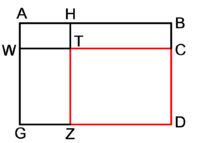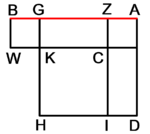ספר האלזיברא
From mispar
ספר האלזיברא
לרבי שמעון מטוט
לרבי שמעון מטוט
Contents[hide]Introduction |
|
| After the praise to God, the name of his praise is Glory | [1]אחרי התהלה לאל אשר שם תהלתו תפארת |
| Illuminating beginning of any discussion and action | ופתח מאיר כל מאמר ומעשה |
| Blessed and exalted be his name a great exaltation | יתב' ויתע' שמו עלוי רב אמן |
Definitions of algebraic terms |
|
| I Start by saying that you should know that the Christians regarded one of the expressions in the equation of the algebraic calculation as having an unknown number, and made it one whole thing in their calculations, which they called cosa. | אתחיל ואומר ראוי שתדע כי הנוצרים בחשבון האלזיברא יקחו חלק אחד מן השאלה בלתי ידוע מספרו ויעשוהו בחשבונם דבר אחד שלם ויקראוהו קוֹסָא |
| They wanted to signify two meanings by this word: one whole thing and an unknown thing, which we do not know. | רצונם להורות בזאת התיבה שני ענינים דבר אחד שלם ודבר נעלם לא ידענוהו |
| Hence, I am doing the same in my translation, and call it davar [= a "thing"]. | וכן ולפי כן אעשה גם אני בהעתקתי זאת ובשם אקראנו דבר |
| They called the product of the thing by itself çenso. | וכפל הדבר בעצמו יקראוהו צֵינְסו |
| I asked the grammarians of their language about the meaning of this word and they told me that it indicates a fixed number. They meant by this an unknown fixed number. | ושאלתי לחכמי דקדוק לשונם על הוראת זאת התיבה ואמרו לי כי היא מורה מספר קצוב רצונם בזה מספר קצוב לא ידענוהו |
| Since I did not find in our language one word that has this meaning, and I did not want to extend my speech by using two words to indicate this meaning, or to invent a new word in the language, I called it by the Hebrew word merubaʼ [= a square] as it is. | ובעבור כי לא מצאתי בלשוננו תיבה אחת תורה זאת ההוראה ולא רציתי להאריך בדבורי להורות זאת ההוראה בשתי תיבות או לחדש תיבה בלשון קראתיהו בשם מרובע כאשר הוא |
| They called the square that is multiplied by it self çenso di çenso, and I named it merubaʼ ha-merubaʼ [= a square of the square]. | ולכפל המרובע בעצמו יקראוהו צֵינְסו דֵצֵינְסו ואני אקראנו מרובע המרובע |
| They called the cube number cubo. | ולמספר המעקב יקראוהו קוּבוּ |
| They called the cube cube cubo di cubo. | ולמעקב המעקב קוּבוּ דֵקוּבוּ |
| The units of the number are called numeri, as their usage in all other places. | ולאחדי המספר נוּמְרִי כמנהגם בכל שאר המקומות |
First Section: Preliminary Study of the Foundation of Algebra |
|
| After my introduction, I shall discuss the teaching of some principles that should be known and precede the study of algebra. | ואחרי הקדמתי זאת אדבר בלמוד שרשים צריכים לדעתם ולהקדימם ללמודי חשבון האלזיברא |
| I will explain them as much as I can, starting by that: | ואבארם כפי אשר תשיג ידי וזה החלי |
|
א כאשר רצית לכפול שורש מספר ידוע בשורש מספר ידוע |
|
כפול המספר האחד בחבירו ושורש העולה הוא מה שרצית |
|
ולקרבו אל ציורך אמשול לך משל |
|
כאשר רצית לכפול שורש מספר ה' בשורש מספר [י"ב][2] |
|
כפול ה' בי"ב יעלה ס' |
|
[3]ושורש ס' הוא מה שרצית לדעת |
|
ב ואם רצית לכפול שורש מספר ידוע במספר ידוע |
|
עשה מן המספר מרובע בכפול אותו בעצמו אחר תכפול המרבע הא' בחבירו ושורש העולה הוא מה שרצית לדעת |
|
המשל רצית לכפול שורש מספר ז' במספר ג' |
|
עשה מג' מרובע והוא ט' |
|
ועתה תכפול ז' בט' יעלה ס"ג |
|
ושורש ס"ג הוא המבוקש |
|
וזה מפני כי יחס מרובע אל מרובע כיחס צלעו אל צלעו שנוי ר"ל כפול |
|
על כן ראוי לכפול מרובע ז' בכפל ג' בעצמו |
|
מתמונת י"א מן המאמר השמיני לאקלידס |
|
ג ואם [רצית][4] לכפול שורש מעקב ידוע בשורש מעקב ידוע |
|
כפול המעקב האחד בחבירו ושורש המעקב העולה הוא מה שרצית |
|
המשל רצית לכפול שורש מעקב ה' בשורש מעקב ו' |
|
כפול ה' בו' יעלה ל' |
|
ושורש מעקב ל' הוא המבוקש |
|
ד ואם רצית לכפול שורש מעקב ידוע במספר ידוע |
|
עשה מן המספר מעקב וכפול המעקב הא' בחבירו ושורש מעקב העולה הוא מה שרצית |
|
המשל רצית לכפול שורש מעקב ה' במספר ג' |
|
עשה מן ג' מעקב והוא כ"ז |
|
וכפול ה' בכ"ז יעלה קה"ל |
|
ושורש מעקב קה"ל הוא המבוקש |
|
וזה מפני כי יחס מעקב אל מעקב כיחס צלעו אל צלעו משלש |
|
מתמונת י"ב מן המאמר השמיני לאקלידס |
|
ה ואם רצית לכפול שורש מעקב ידוע בשורש מרובע ידוע |
|
[5]עשה מן המרבע מעקב ומן המעקב מרבע |
|
ובזה המעשה השוית השרשים ועשית כל אחד מהם שורש מרבע מן שרש מעקב |
|
אחר כן תכפול אחד מהם בחבירו ושורש מרובע מן שרש מעקב העולה הוא מה שרצית |
|
ולמען תשכיל אמשול לך משל במספרים בעלי שורש ואומר רצית לכפול שורש מרובע ט' שהוא ג' בשורש מעקב ח' שהוא ב' |
|
וידוע כי מכפל ג' בב' יעלה ו' והוא המבקש |
|
ולפי הדרך אשר זכרנו |
|
ראוי לעשות מן ט' מעקב והוא תשכ"ט |
|
ומן ח' מרבע והוא ס"ד |
|
כפול ס"ד בתשכ"ט יעלה מ"ו אלפים ותרנ"ו |
|
והנה שרש מרובע מן שרש מעקב מ"ו אלפים ותרנ"ו הוא המבוקש |
|
ולהוסיף באור נשיב המבקש אל מספר ונוכל עשוהו מפני כי המספרים אשר לקחנו במשלנו הם בעלי שרש |
|
ונאמר שרש מעקב מ"ו אלפים ותרנ"ו הוא ל"ו ושרש מרבע ל"ו הוא ו' והנה מספר ו' הוא המבקש כאשר אמרנו בתחלה |
|
מופת זה מובן למבין ממופתי הלמודים הקודמי' |
|
ו ואם רצית לכפול שורש שורש מרובע ידוע בשרש שרש מרובע ידוע |
|
כפול המרבע האחד בחבירו ושרש שרש מרבע העולה הוא מה שרצית |
|
המשל רצית לכפול שרש שרש מרובע ד' בשרש שרש מרובע ז' |
|
כפול ד' בז' יעלה כ"ח |
|
ושרש שרש מרבע כ"ח הוא המבוקש |
|
ז ואם רצית לכפול שרש שרש מרבע ידוע במספר ידוע |
|
עשה מן המספר מרבע וממרבעו מרבע וכפול האחד בחבירו ושרש שרש מרבע העולה הוא מה שרצית |
|
המשל רצית לכפול שרש שרש מרבע ה' במספר ב' |
|
עשה מן ב' מרבע והוא ד' ומן [6]ד' מרובע והוא י"ו |
|
כפול ה' בי"ו יעלה פ' |
|
ושרש שרש מרובע פ' הוא מה שרצית לדעת |
|
ח ואם רצית לכפול שרש מעקב ידוע בשרש שרש מרובע ידוע |
|
עשה מן המעקב מרובע וממרבעו מרבע |
|
ומן המרובע עשה מעקב |
|
ובזה המעשה השוית השרשים ועשית כל אחד מהם שרש שרש מרבע מן שרש מעקב |
|
אחר תכפול האחד מהם בחבירו ושרש שרש מרבע מן שרש מעקב העולה הוא מה שרצית לדעת |
|
המשל רצית לכפל שרש מעקב ג' בשרש שרש מרבע ד' |
|
עשה מן המעקב שהוא ג' מרבע והוא ט' ומן ט' מרבע והוא פ"א |
|
אחר כן תעשה מן ד' מעקב יהיה ס"ד |
|
כפול פ"א בס"ד יעלה ה' אלפים וקפ"ד |
|
ושרש שרש מרבע מן שרש מעקב ה' אלפים ופק"ד הוא מה שרצית |
|
ט ואם רצית לכפול מספר ה' ושרש מספר ו' בעצמו |
|
עשה על הדרך הזאת |
|
כפול ה' בעצמו יעלה כ"ה |
|
עוד תכפול שרש ו' בעצמו יעלה ו' |
|
הרי ל"א שמרם |
|
עוד תכפול מספר ה' בשרש ו' פעמים על הדרך הזאת |
|
ראשונה תכפול מספר ה' בשרש ו' ועשה מן ה' מרובע והוא כ"ה כפלהו בו' יעלה ק"נ והנה שרש ק"נ הוא העולה מכפל מספר ה' בשרש מספר ו' |
|
עוד תכפול שרש ק"נ במספר ב' מפני כי אתה רוצה אותו פעמים ותעשה מן ב' מרבע והוא ד' כפול ד' בק"נ יעלה ת"ר |
|
הנה תאמר כי מספר ל"א אשר שמרת ושרש מספר ת"ר מחברים הוא מה שרצית לדעת |
|
ולמען תשכיל אתאר לך תמונת הכפל |
|
ואוציא מכל אחד מהמספרים אשר בתמונה קוים נמשכים בה אל המספרים אשר ראוי [7]לכפלו בהם |
|
|
|
|
י ואם רצית לכפול שרש ל"ב פחות מספר ג' בעצמו |
|
עשה ראשונה מן ג' מרובע והוא ט' |
|
ועתה תכפול שרש ל"ב פחות שרש ט' בעצמו על הדרך הזאת |
|
כפול תחלה שרש ל"ב בעצמו יעלה ל"ב |
|
עוד תכפול שרש ט' פחות בעצמו יעלה ט' יותר |
|
כי ראוי שתדע כי מכפל חסרון בחסרון יעלה יתרון כאשר אבאר |
|
על כן תחבר ט' בל"ב יעלה מ"א שמרם |
|
עוד תכפול שרש ל"ב בשרש ט' פחות פעמים על הדרך האמור למעלה יעלה בידך שרש אלף וקנ"ב פחות |
|
כי לעולם מכפל איזה מספר או איזה שיעור שיהיה בחסרון יעלה חסרון |
|
הנה תאמר כי מספר מ"א אשר שמרת פחות שרש אלף וקנ"ב הוא המבוקש |
|
יא ואם רצית לכפול שרש מ"ח ושרש י' בשרש מ"ח פחות שרש י' |
|
כפול ראשונה שרש מ"ח בעצמו יעלה מ"ח |
|
עוד תכפול שרש י' יותר בשרש י' פחות יעלה י' פחות |
|
חסרם ממ"ח |
|
עוד תכפול שרש מ"ח בשרש י' יותר יעלה שרש ת"פ יותר |
|
הרי בידך ל"ח ושרש ת"פ יותר |
|
עוד תכפול שרש מ"ח בשרש י' פחות יעלה שרש ת"פ פחות |
|
על כן תחסרנו מל"ח ושרש ת"פ יותר ישאר בידך מספר ל"ח והנה הוא המבוקש |
|
| |
| Rules of multiplication for expressions of the type (a+b) and (a-b) | |
|---|---|
| Now I will give you a rule: | ועתה אתן לך כלל |
|
מכפל איזה מספר ביתרון יעלה יתרון |
|
ומכפל איזה [8]מספר בחסרון יעלה חסרון |
|
ומכפל יתרון ביתרון יעלה יתרון |
|
ומכפל יתרון בחסרון יעלה חסרון |
|
ומכפל חסרון בחסרון יעלה יתרון כאשר אמרנו למעלה |
| Geometric illustration | |
|
ולהראותך מופת זה נתאר תמונה ונביא דמיון במספר |
|
רצינו לכפול מספר י"ב פחות מספר ד' במספר ח' פחות מספר ב' |
|
ונתאר תמונה כפי המשל הנזכר |
|
|
|
|
ויהיה שטח אבג"ד |
|
צלע א"ב ממנו י"ב מדות |
|
וצלע א"ג ממנו ח' מדות |
|
ונחסר מצלע א"ב חלק א"ה ממנו ד' מדות |
|
ומצלע א"ג נחסר צלע א"ו ממנו ב' מדות |
|
ונעביר מנקדת ה' קו ה"ז נכוחי לקוי א"ג וב"ד ומנקדת ו' קו ו"ח נכוחי לקוי א"ב וג"ד |
|
ויחתכו שני אלה הקוים בתוך השטח על נקדת ט' |
|
ויחלקוהו לארבעה שטחים |
|
לשטח ט"ג ושטח ט"א ושטח ט"ב שלשתם יחד נקראם רושם התמונה ושטח ט"ד הרביעי ונקראהו המבוקש כי מספרי שבריו שוה למספר המבקש העולה מכפל המספרים הנזכרים כאשר אתה רואה |
|
אין צורך להאריך במופת על זה אליך |
|
ועתה נכפול המספרים הנז' אחד מהם בחברו כפי הדרך הנזכ' |
|
ונתחיל לכפול י"ב בח' יעלה צ"ו כמספר שברי שטח א"ד כולו |
|
עוד נכפול י"ב במספר ב' פחות יעלה כ"ד פחות כמספר שברי שטח ט"א ושטח ט"ב |
|
עוד נכפול מספר ח' במספר ד' פחות יעלה ל"ב פחות כמספר [9]שברי א' שטח ט"א ושטח ט"ג |
|
ואם נחבר כ"ד ול"ב יעלה נ"ו כמספר שברי הרושם ושברי שטח ט"א מחברים |
|
| |
|
ואם נחסרם משברי שטח א"ד כלו שהם צ"ו ישאר שטח ט"ד המבקש פחות שטח ט"א שמרהו |
|
| |
|
ותשלים לכפול המספרים הנזכר' ותכפול ב' פחות בד' פחות יעלה ח' כמספר שברי שטח א"ט |
|
וצריך אתה להוסיפו על השמור להשלים שטח ט"ד המבקש |
| |
|
על כן יאמר כי מכפל חסרון בחסרון יעלה תוספת |
|
ולקרבו אל ציורך אתאר גם לך תמונת הכפל באופן אשר צירתי תמונת הכפל הקודמת |
|
|
|
|
יב ואם רצית לחבר שרש י"ב בשרש מ"ח דרך משל |
|
כפול י"ב במ"ח יעלה תקע"ו |
|
והנה שרש תקע"ו כ"ד |
|
קח שני דמיוניו יעלה מ"ח |
|
חבר אליו שני המרבעים שהם י"ב ומ"ח יעלה ק"ח |
|
והנה שרש ק"ח הוא המבקש |
|
מופת זה נחבר צלע מרבע י"ב וצלע מרבע מ"ח על יושר ויהיו שני חלקי קו אחד ישר |
|
וכבר נתבאר בתמונה הרביעית מן המאמר השני לאיקלידס |
|
כי כאשר נחלק קו ישר לב' חלקים איך שקרה הנה מרבע הקו כלו שוה לשני המרבעים ההוים משני החלקים ולכפל השטח הנצב הזויות אשר יקיפו בו שני החלקים |
|
ועתה הנה כאשר כפלנו שני המרובעים זה בזה הנה שרש העולה שהוא תקע"ו הוא שוה לשטח הנצב הזויות ההוה משני החלקים |
|
וכאשר לקחנו שני דמיוניו עלה בידנו כפל השטח הנצב הזויות אשר יקיפו בו שני החלקים וכאשר חברנו אל זה שני המרובעים עלה בידנו מרבע הקו כלו ושרשו הוא המבקש |
|
יג ואם רצית לחבר שרש ח' בשרש י"ט |
|
כפול ח' בי"ט יעלה קנ"ב והנה אין לו שרש |
|
קח שני דמיוני שרש קנ"ב על הדרך הזאת כפול שרש קנ"ב במספר ד' יעלה שרש תר"ח שמרהו |
|
חבר שני המרבעים שהם ח' וי"ט יעלה כ"ז |
|
הנה תאמר כי שרש העולה מחבור כ"ז עם שרש תר"ח הוא המבקש |
|
מופת זה הלמוד מובן מאשר לפניו |
|
יד ואם רצית לחבר שרש מעקב צ"ו עם שרש מעקב שכ"ד |
|
קח המספר היותר גדול שימנה שני אלה המספרי' והוא י"ב |
|
חלק אליו צ"ו יגיע בחלוק ח' |
|
עוד תחלק אליו שכ"ד יגיע כ"ז |
|
הנה צ"ו הוא ח' חלקים מכ"ז ממספר שכ"ד |
|
קח שרש מעקב ח' חלקים מכ"ז יהיה ב' שלישים |
|
הנה כי שרש מעקב צ"ו הוא ב' חלקי' מג' משרש שכ"ד |
|
חבר ב' וג' יעלה ה' |
|
הנה חברנו שני שרשי שני המעקבים ועלה ה' |
|
אח"כ תעשה מן ה' מעוקב משרש מעקב והוא קכ"ה |
|
והנה עלה בידינו מעקב חלקי שני שרשי שני המעקבים כאשר חוברו שמרהו |
|
ועתה לדעת שעור כל אחד מאלו הקכ"ה במדה שבה המעקב האחד צ"ו והמעקב השני שכ"ד נעשה על הדרך הזאת |
|
קח החלק האחד מהחמשה חלקי' הנז' והנה הוא חצי שרש מעקב צ"ו |
|
עשה מן חצי מעקב ויעלה בידך שמינית אחד |
|
הנה מעקב החלק האחד הוא שמינית מספר צ"ו שהוא י"ב |
|
כפול י"ב בקכ"ה אשר שמרת יעלה אלף ות"ק |
|
והנה שרש מעקב אלף ות"ק הוא המבקש |
|
הנה לפי דרכי בהדריכי אותך במעגלי יושר לחשוב זה החשבון בדרך חכמה הורתיך[note 1] המופת |
|
טו ואם רצית לחלק שרש ל על שרש ו' |
|
חלק ל' לו' יעלה ה' ושרשו הוא המבוקש |
|
וזה מפני כי יחס מרובע אל מרובע כיחס צלעו אל צלעו שנוי |
|
יו ואם רצית לחלק מספר כ' על שרש י' |
|
עשה מן כ' מרבע והוא ת' חלק ת' לי' יגיע מ' הוא המבקש |
| I present a teaching, if you look carefully, you will understand from it the proof of the two teachings that follow it: | הנה אקדים למוד אחד אם תתבונן תבין ממנו מופתי שני הלמודי' הנמשכי' אחריו |
|
יז אם רצית לכפול שרש ח' פחות שרש ד' בשרש ח' ושרש ד' יותר דרך משל |
|
חסר ד' מח' ישאר ד' ומספר ד' הנשאר הוא המבוקש |
|
ולמען תדע כי כן הוא נתאר תמונת הכפל ונכפול המספרי' על הדרך הנודע |
|
|
|
|
ונתחיל לכפול שרש ח' בשרש ח' יעלה מספר ח' |
|
עוד נכפול שרש ח' בשרש ד' יותר יעלה שרש ל"ב יותר |
|
הנה בידינו מספר ח' ושרש ל"ב שמרהו |
|
ונשלים חשבוננו ונכפול שרש ד' יותר בשרש ד' פחות יעלה מספר ד' פחות |
|
עוד נכפול שרש ח' בשרש ד' פחות יעלה שרש ל"ב פחות |
|
ועתה נפחות ממספר ח' ושרש ל"ב השמור מספר ד' ושרש ל"ב שראוי לפחות נשאר מספר ד' כאשר אמרנו והוא המבקש או נאמר כי שרש י"ו הוא המבקש |
|
| |
|
יח ואם רצית לכפול שרש ח' פחות שרש ד' בשני שרשים אחרים יהיה העולה שרש ס"ד לא שרש י"ו |
|
חלק ס"ד לי"ו יגיע בחלוק ד' |
|
ועתה כפול בח' יעלה ל"ב |
|
עוד תכפלהו בד' יעלה י"ו והנה יעלה י"ו |
|
והנה בשרש ל"ב ושרש י"ו ראוי לכפלם ויהיה העולה שרש ס"ד וזה מובן בעצמו |
|
יט ואם רצית לחלק שרש ס"ד על שרש ח' פחות שרש ד' |
|
חסר ד' מח' ישאר ד' כפול ד' הנשאר בעצמו יעלה י"ו |
|
חלק ס"ד לי"ו יגיע ד' |
|
ועתה כפול ד' המגיע בחלוק בח' יעלה ל"ב |
|
עוד תכפלהו בד' אשר אמרת לפחות שרשו משרש ח' יעלה י"ו |
|
והנה שרש ל"ב ושרש י"ו מחוברים הוא המבוקש |
|
זה הלמוד הולך בדרך הקודם כי לעולם המספר המתחלק הוא שוה למספר העולה מכפל המספר העולה בחלוק במספר אשר אליו יתחלק המתחלק |
|
כ וכן אם רצית לחלק שרש ס"ד על שרש ח' ושרש ד' יותר |
|
חסר ד' מח' ישאר ד' כפול ד' הנשאר בעצמו יעלה י"ו |
|
חלק ס"ד לי"ו יעלה ד' |
|
ועתה כפול ד' המגיע בחלוק בח' יעלה ל"ב |
|
עוד תכפלהו בד' יעלה י"ו |
|
והנה שרש ל"ב פחות שרש י"ו הוא המגיע בחלוק |
|
הנך רואה כי זה הלמוד הולך בדרך הלמוד הקודם לא פחות ולא יותר |
|
רק תחת אמרך בלמוד הקודם שהמבקש הוא שרש ל"ב ושרש י"ו מחברים בזה הלמוד אמרת שהוא שרש ל"ב פחות שרש י"ו |
|
כא ואם רצית לחלק מספר ח' על שרש ח' ומספר ב' יותר או על שרש פחות מספר ב' |
|
עשה ממספר ח' מרבע יהיה ס"ד |
|
וממספר ב' מרובע יהיה ד' |
|
והנה אתה עתה שבת אל שני הלמודים הקודמים לזה והקש על זה |
|
כב ואם רצית לחלק שרש מרבע ו' בשרש מעקב י' |
|
עשה מן ו' מעקב יעלה רי"ו |
|
ומן י' מרבע יהיה ק' |
|
ובזה המעשה השוית השרשים ועשית כל אחד מהם שרש מרבע מן שרש מעקב |
|
ועתה חלק רי"ו על ק' ויגיע ב' וד' חלקי' מכ"ה |
|
ושרש מרבע מן שרש מעקב ב' וד' חלקי' מכ"ה הוא המבקש |
|
כג ואם רצית לחלק שרש מעקב ה' בשרש שרש מרבע ח' |
|
עשה מן ה' מרבע מרבע ויהיה תרכ"ה |
|
גם תעשה מן ח' מעקב יהיה תקי"ג |
|
והנה השוית השרשים |
|
חלק תרכ"ה בתקי"ג ויגיע אחד וקי"ג חלקים מתקי"ג |
|
והנה שרש שרש מרבע מן שרש מעקב א' וקי"ג חלקים מתקי"ג הוא המבקש |
|
כד ואם רצית לגרוע שרש ח' משרש י"ח דרך משל |
|
כפול ח' בי"ח יעלה קמ"ד |
|
הוצא שרשו והוא י"ב |
|
קח שני דמיוניו ויהיו כ"ד |
|
חבר ח' וי"ח יהיו כ"ו |
|
חסר כ"ד מכ"ו ישאר ב' ושרש ב' הוא מה שרצית |
|
ולהראותך מופת על זה צריך אני להשכילך |
|
כי כאשר נחלק קו ישר לשני חלקי' איך שקרה הנה מרבעי שני החלקי' שוים לכפל השטח הנצב הזוית אשר יקיפו בו שני החלקי' ולמרבע ההוה ממותר החלק הגדול על הקטן |
| Geometric illustration
|
|
|
ויהיה קו ישר עליו א"ב ויחולק איך שקרה על נקודה ג' |
|
עוד נחלק מן קו א"ג חלק א"ז ממנו שוה לקו ג"ב שהוא החלק הקטן |
|
וישאר קו ז"ג הוא מותר החלק הגדול על הקטן |
|
הנה אומר כי כפל השטח הנצב הזויות אשר יקיפו בו קוי א"ג ג"ב עם המרבע ההוה מן ז"ג מחברים יהיו שוים לשני המרבעים ההוים מן א"ג וג"ב כאשר יחברו |
|
ונעשה מן קו א"ג מרבע אגד"ה ומן קו ג"ב מרבע גבח"ו |
|
ומנקודת ז' נמשיך קו ז"י נכחי לשני קוי א"ד ג"ה |
|
ונמשיך קו ו"ח על יושר עד אשר יפגיש קו ז"י על נקודת כ' |
|
ועתה מפני כי ג"ב שוה לקו א"ז יהיה קו ז"ב שוה לקו א"ג שהוא החלק הגדול וקו ב"ו לקו ג"ב שהוא החלק הקטן |
|
א"כ שטח ב"כ שוה לשטח נצב הזויות אשר יקיפו בו שני קוי א"ג ג"ב אשר הם שני חלקי הקו כלו |
|
וגם כן מפני כי קו א"ד שוה לקו א"ג וקו א"ז שוה לקו ג"ב יהיה שטח ז"ד גם כן שוה לשטח הנצב הזויות אשר יקיפו בו שני קוי א"ג ג"ב |
|
אם כן שני שטחי כ"ב וז"ד שוים לשטח לכפל השטח הנצב הזויות אשר יקיפו בו שני קוי א"ג ג"ב |
|
ושטח כ"ה הנשאר מן שני מרבעי שני החלקים הוא מרבע שוה למרבע ההוה מן ז"ג שהוא מותר החלק הגדול על הקטן |
|
מפני כי קו כ"ח שוה לקו ז"ג וקו ה"ח שהוא צלעו השני שוה לקו ז"ג |
|
גם כן מפני כי הוא מותר קו ג"ה שהוא שוה לחלק הגדול על קו ג"ח שהוא שוה לחלק הקטן |
|
הנה שני המרובעים ההוים מן א"ג וג"ב מחברים שוים לשני שטחי ב"כ וז"ד אשר כל אחד מהם שוה לשטח אשר יקיפו בו קוי א"ג ג"ב שהם שני חלקי הקו ולמרבע כ"ה שהוא שוה למרבע ההוה מן ז"ג שהוא מותר החלק הגדול על הקטן כאשר יחברו |
|
| |
|
וזה מה שרצינו לבאר |
|
ונעשה דמיון במספר |
|
ויהיה קו א"ג צלע מרבע שבריו י"ח |
|
וחלק א"ג ממנו צלע מרבע שבריו ח' |
|
והוא מרובע א"ה |
|
והנה כאשר כפלנו ח' בי"ח הנה שרש העולה שוה לשטח נצב הזויות אשר יקיפו בו שני החלקי' |
|
וכאשר לקחנו שני דמיוניו עלה בידינו כפל השטח הנצב הזויות אשר יקיפו בו שני החלקים |
|
וכאשר חסרנו מכ"ו שהוא שברי שני המרובעי' נשאר בידנו מרבע מותר החלק הגדול על הקטן |
|
| |
|
ושרשו הוא המבקש |
Second Section: Algebra |
|
| Now, by his awful name among the nations | ועתה בשם שמו בגוים נורא |
| I begin to discuss the study of the algebraic calculation | אחל לדבר בלמודי חשבון האלזיברא |
| I will explain it to the best of my narrow intellectual ability | ואבארם ביד שכלי הקצרה |
| Before I begin, I offer a clarified introduction: | וטרם החילי אציע הצעה מבוארה |
Introduction |
|
|
ואומר ראוי שתשכיל ותדע כי יחס מרבע המרבע אל המעקבי' כיחס המעקב אל המרבע וכיחס המרבע אל הדבר וכיחס הדבר אל האחד |
|
וזה מפני כי מספר האחדים אשר בשרש בדבר כמספר הדברי' אשר במרבע וכמספר המרבעי' אשר במעקב וכמספר המעקבי' אשר במרבע המרבע |
| You should keep this introduction in mind, because you will need it for the proofs of the teachings below. | וזאת ההצעה שמרה כי תצטרך אליה במופתי הלמודי' הבאי' אחריה |
| Here I start: | וזה החלי |
The six canonical equations |
|
|
א כאשר הדברים שוים לאחדים |
|
חלק האחדים לדברי' והמגיע בחלוק הוא הדבר זה מובן בעצמו |
|
שאלה רציתי לחלק מספר עשרה לשני חלקים כאשר חולק החלק האחד בחברו הגיע בחלוק ה' |
|
עשה על הדרך הזאת |
|
אמור החלק אשר אליו יתחלק הוא דבר שרש אחד |
|
והחלק המתחלק הוא בהכרח חמשה דברים שרשים כמספר אשר הגיע בחלוק |
|
הנה שני החלקי' מחברים הם ששה דברים והם שוים למספר עשרה |
|
וכפי הדרך הנזכר בזה הלמוד |
|
ראוי לחלק מספר עשרה לו' ויגיע בחלוק א' וב' שלישי' וככה הדבר |
|
ב כאשר המרבעים צינסי שוים לאחדים מספרי' |
|
חלק האחדים למרבעים ושרש המגיע בחלוק הוא הדבר שרש |
|
שאלה רציתי למצא מספר כאשר חסר ממנו שלישיתו מרבע הנשאר הוא מספר כ' |
|
עשה על הדרך הזאת |
|
אמור זה המספר אשר שני שלישיו הם שרש כ' הוא דבר אחד |
|
כפול ב' שלישיו בעצמם יהיו ד' תשיעיות מרבע המספר כלו אשר רציתי למצא |
|
ולפי הדרך הנז' בזה הלמוד |
|
ראוי לחלק מספר כ' לד' תשיעיות והמגיע בחלוק הוא מ"ה וככה מרבע כל המספר |
|
ושרשו הוא מה שרצית |
|
ג כאשר המרבעים שוים לדברים |
|
חלק הדברים למרבעים והמגיע בחלוק הוא הדבר |
|
זה הלמוד הולך בדרך הלמוד הראשון מפני כי יחס המרבע אל הדבר כיחס הדבר אל האחד כאשר אמרנו בהצעה |
|
וע"כ אם מרבע אחד ישוה לג' דברים דרך משל דבר אחד ישוה לג' אחדים בהכרח |
|
שאלה רציתי למצא מספר כאשר חסר ממנו שלישית הנשאר הוא שרש המספר כלו |
|
עשה על הדרך הזאת |
|
אמור ב' שלישי זה המספר הוא דבר אחד |
|
אם כן המספר אחד כלו הוא דבר אחד וחצי הנה דבר אחד וחצי הוא שוה למרבע אחד |
|
וכפי הדרך הנזכ' ראוי לחלק א' וחצי לאחד יגיע א' וחצי וככה הדבר שהוא שני שלישי המספר אשר רצית למצא |
|
אם כן המספר כלו הוא ב' ורביע |
|
ד כאשר הדברים והאחדים שוים למרבעים |
|
חלק הדברי' והאחדי' למרבעי' |
|
והדברי' המגיעי' בחלוק תחצה |
|
וכפול המחצית בעצמו |
|
והעולה הוסיפהו על האחדי' המגיעי' בחלוק |
|
והעולה קח שרשו |
|
והוסיפהו על מחצית הדברי' המגיעי' בחלוק והעולה הוא הדבר |
| Geometric illustration | |
|---|---|
|
ולהראותך זה לעין השכל נתאר תמונה ונביא דמיון במספר |
|
|
|
|
ויהיה קו א"ב עשר מדות |
|
וחלק איך שקרה על נקודת ז' ויהיה חלק א"ז ממנו ח' מדות |
|
ונעשה מן א"ב מרבע אבג"ד |
|
ונעביר בו מנקודת ז' קו ז"ח נכחי לקו א"ג וב"ד |
|
הנה בידינו שטח א"ח שהוא שמנה דברים במספר מדות קו א"ז |
|
כי כל מדה ממדות א"ז מחזקת בשטח א"ח דבר אחד |
|
ושטח ז"ד אשר שבריו כ' מדות שניהם יחד שוים למרבע א"ד |
|
ועתה הנה לפנינו קו א"ז ארכו ח' מדות כמספר הדברים |
|
ונחלקהו לחצאין על נקודת ט' |
|
והוסף עליו קו ז"ב |
|
וכבר נתבאר בתמונה הששית מן המאמר השני לאיקלידש כי השטח הנצב הזויות אשר יקיף בו הקו כלו עם התוספת והתוספת אשר הוא שוה לשטח ז"ד אשר תשבורתו מספר ב' במשלנו שניהם יחד שהם ל"ו שוים למרובע הקו המורכב מחצי הקו והתוספת אשר הוא קו ט"ב בתמונתנו |
|
| |
|
על כן אם תקח שרש ל"ו שהוא ו' יעלה בידך מדת הקו המורכב מחצי הקו והתוספת שהוא קו ט"ב |
|
הוסף עליו מחצית הדברי' שהוא מספר ד' כמספר מדות קו א"ט יעלה י' כמדת כל קו א"ב צלע המרבע והוא הדבר |
|
שאלה רצינו למצא מספר כאשר הוספנו עליו כ"ח יהיה שוה לשני דמיוני מרבעו |
|
עשה על הדרך הזאת |
|
אמור זה המספר הוא דבר אחד |
|
וכאשר הוספנו עליו כ"ח יהיה דבר אחד וכ"ח אחדים והם שוים לשני מרבעים |
|
והנה כפי הדרך הנזכר בזה הלמוד |
|
ראוי לחלק דבר אחד וכ"ח אחדים לשנים מספר המרבעי' ויגיע בחלוק חצי דבר וי"ד אחדים |
|
קח מחצית חצי דבר שהגיע בחלוק יהיה רביע דבר |
|
כפלהו בעצמו יהיה חלק אחד מי"ו |
|
הוסיפהו על י"ד מספר האחדי' המגיעי' בחלוק יעלה י"ד וחלק אחד מי"ו |
|
קח שרשו והוא ג' וג' רביעים |
|
הוסיפהו על מחצית הדברים המגיעים בחלוק שהוא רביע דבר יעלה ד' וככה הדבר |
|
| |
|
ה כאשר המרבעים והאחדים שוים לדברים |
|
חלק הדברי' והאחדי' למרבעי' |
|
והיוצא בחלוק הדברי' תחצה |
|
ותכפול המחצית בעצמו |
|
והעולה תגרע ממנו המספר היוצא בחלוק האחדי' |
|
והנשאר זה שרשו |
|
והוסיפהו על מחצית היוצא בחלוק הדברי' והעולה הוא הדבר |
| Geometric illustration | |
|
ולהראותך מופת זה נתאר תמונה ונביא דמיון במספר |
|
|
|
|
ויהיה קו א"ג הישר ח' מדות |
|
ונחלקהו לב' חלקי' שוים על נקודת ז' ויהיה א"כ קו ג"ז ד' מדות |
|
עוד נחלקה לשני חלקי' בלתי שוים על נקודת ב' ויהיה ג"ב ב' מדות |
|
ונעשה מן קו א"ב מרבע אבה"ו' |
|
ונמשיך קו ה"ו עד ח' ויהיה קו ח"ה שוה לקו ח"ג |
|
גם נעביר קו ג"ה |
|
ולפי זה יהיה שברי שטח ג"ו י"ב מדות |
|
ועתה הנה לפנינו מרבע אבה"ו ושטח ג"ו שבריו י"ב מדות שניהם יחד שוים לשטח א"ה שבריו שמנה דברים כי כל מדה ממדות קו א"ג מחזקת בשטח א"ה דבר אחד |
|
והנה כפי מה שנתבאר בתמונה החמישית מן המאמר השני לאיקלידש יהיה המרבע ההוה מן א"ז שהוא ארבע מדות כמספר מחצית הדברים ומרובעו אם כן ידוע שהוא י"ו שוה לשטח ב"ה שהוא שוה לשטח הנצב הזויות אשר יקיפו בו שני החלקים הבלתי שוים ושבריו ידועים שהם י"ב ולמרבע ההוה מן ז"ב אשר הוא מה שבין שני החלקי' |
|
והנה נחסר שטח ב"ה שהוא י"ב מהמרבע ההוה מן א"ז שהוא י"ו ישאר המרבע ההוה מן ז"ב ידוע |
|
קח שרשו והוסיפהו על קו א"ז שהוא מחצית הדברי' יהיה קו א"ב ידוע שהוא צלע המרבע |
|
וזה מה שרצינו |
|
שאלה סוחר אחד הלך לסחור ובידו קצבת מה והרויח ו' עוד חזר עם הקצבה והרויח כפי הערך שהרויח בפעם הראשונה ונמצא בידו כ"ז רציתי לדעת מספר הקצבה הראשונה |
|
עשה על הדרך הזאת |
|
אמור הקצבה הו' הראשונה היא דבר אחד |
|
ומזה הדבר הצליח ועשה דבר אחד וו' וכפי זה הערך מדבר אחד וו' עשה כ"ז |
|
הנה יחס דבר אחד עם דבר אחד וו' כיחס דבר אחד וו' עם כ"ז אחדים |
|
הנה לפנינו ג' שעורים מתיחסים |
|
וכבר נתבאר מתמונת י"ז מן המאמר הששי לאיקלידש כי הכאת הראשון באחרון כמו הכאת האמצעי בדומה לו |
|
ועתה כפול דבר אחד שהוא הראשון בכ"ז אחדים שהוא האחרון יעלה כ"ז דברים |
|
עוד תכפול דבר אחד וו' שהוא האמצעי בעצמו יעלה מרבע אחד וי"ב דברים ול"ו אחדים |
|
ועתה חסר הי"ב דברים משני אלה השעורים השוים |
|
ישארו ט"ו שוים למרבע אחד ול"ו אחדים |
|
וכפי הדרך אשר אמרנו בזה הלמוד ראוי לחלק ט"ו מספר הדברי' ול"ו מספר האחדי' לאחד שהוא מספר המרבע ויגיע ט"ו דברי' ול"ו אחדי' |
|
אחר תחצה הדברי' יהיו ז' וחצי |
|
כפלם בעצמם עלה נ"ו ורביע |
|
תגרע מהם ל"ו אחדי' ישאר כ' ורביע |
|
קח שרשו והוא ד' וחצי |
|
הוסיפהו על מחצית הדברים שהוא ז' וחצי יעלה י"ב וככה הדבר שהוא הקצבה הראשונה |
|
| |
|
ו כאשר המרבעים והדברי' שוים לאחדים |
|
תחלק הדברי' והאחדי' למרבעי' |
|
והיוצא בחלוק הדברי' תחצה |
|
וכפלת את המחצית בעצמו |
|
והעולה הוסיפהו על היוצא בחלוק האחדי' |
|
ושרש העולה פחות מחצית הדברי' המגיעי' בחלוק הוא הדבר |
| Geometric illustration | |
|
ולהראותך מופת זה |
|
|
|
|
נתאר מרבע אגה"ד' |
|
ונחבר אליו שטח בגה"ו שבריו ידועים שוים למספר שני דברים דרך משל |
|
שניהם יחד ר"ל המרבע והשטח שוים למספר מ"ח |
|
וצלע ג"ב משטח גבה"ו שעורו ידוע והוא ב' מדות כמספר הדברי' |
|
ועתה לדעת קו א"ג צלע המרבע |
|
נחלק קו ב"ג לחצאין על נקודת ז' |
|
והנה לפנינו קו ג"ב נחלק לחצאין על נקדת ז' ונוסף עליו קו ג"א |
|
וכבר נתבאר בתמונה הששית מן המאמר השני לאיקלידש כי השטח הנצב הזויות אשר יקיף בו הקו כלו עם התוספת והתוספת אשר הוא שוה לשטח א"וֹ אשר שבריו ידועים שהם מ"ח ומרבע חצי הקו אשר תשבורתו ידוע שהוא א' שניהם יחד שהם מ"ט שוים למרבע הקו המרכב מחצי הקו והתוספת אשר הוא קו א"ז |
|
| |
|
על כן אם תקח שרש מ"ט שהוא ז' ככה יהיה קו א"ז |
|
חסר ממנו חצי הקו שהוא ג"ז אשר הוא מדה אחת נשאר קו א"ג ידוע והוא ו' מדות |
|
וזה מה שרצינו לבאר |
Equations of the higher degrees that can be reduced to the canonical equations of the second degree |
|
|
ז כאשר המעקבים שוים לאחדי' |
|
תחלק האחדים למעקבים וככה מספר אחדי המעקב |
|
ושרשו המעקבי' הוא הדבר |
|
זה מובן בעצמו |
|
ח כאשר המעקבי' שוים לדברים |
|
תחלק הדברים למעקבי' |
|
והיוצא קח שרשו המרבעי' וככה הדבר |
|
זה הלמוד הולך בדרך הלמוד השני |
|
מפני כי יחס המעקב אל הדבר הוא כיחס המרבע אל האחד |
|
וזה יובן מן ההצעה |
|
ועל כן אם היה מעקב אחד שוה לט' דברים דרך משל יהיה בהכרח מרבע אחד שוה לט' אחדים גם כן |
|
ט כאשר מרבעי המרבעים שוים לאחדים |
|
תחלק האחדים למרבעי המרבעים |
|
והיוצא קח שרש שרשו וככה הדבר |
|
גם זה מובן מעצמו |
|
י כאשר מרבעי המרבעים שוים לדברים |
|
תחלק הדברים למרבעי המרבעים |
|
והיוצא קח שרשו המעקבים וככה הדבר |
|
זה הלמוד הולך בדרך הלמוד הז' |
|
מפני כי יחס מרבע המרבע אל הדבר כיחס המעקב אל האחד |
|
וזה יובן מן ההצעה |
|
ועל כן אם מרובע מרובע אחד ישוה לכ"ז דברי' מעוקב אחד ישוה לכ"ז אחדי' בהכרח |
|
יא כאשר מרבעי המרבעים שוים למרבעים |
|
תחלק המרבעי' למרבעי המרבעים |
|
ושרש היוצא הוא הדבר |
|
זה הלמוד הולך בדרך השני |
|
מפני כי יחס מרבע המרבע אל המרבע הוא כיחס המרבע אל האחד |
|
וזה יובן מן ההצעה |
|
ועל כן אם מרובע מרובע ישוה לט' מרובעי' מרובע א' ישוה לט' אחדי' |
|
יב כאשר מרבעי המרבעים שוים למעקבים |
|
תחלק המעקבים למרבעי המרבעי' |
|
והיוצא הוא הדבר |
|
זה הלמוד הולך בדרך הלמוד הראשון |
|
מפני כי יחס מרבע המרבע אל המעקב הוא כיחס הדבר אל האחד |
|
כאשר הקדמנו בהצעה |
|
יג כאשר המעקבים והמרבעי' שוים לדברי' |
|
תחלק המרבעי' והדברי' למעקבי' |
|
והמעקבי' המגיעי' בחלוק תחצה |
|
וכפלת המחצית בעצמו |
|
והוסיפהו על הדברי' המגיעי' בחלוק |
|
ושרש העולה פחות מחצית הדברי' המגיעי' בחלוק הוא הדבר |
|
זה הלמוד הולך בדרך הלמוד הששי |
|
מפני כי יחס המעקב והמרבע כל אחד מהם אל הדבר כיחס המרבע והדבר כל אחד מהם אל האחד |
|
כמבואר בהצעה |
|
יד כאשר המעקבי' והדברי' שוים למרבעי' |
|
תחלק הדברי' והמרבעי' למעקבים |
|
והיוצא בחלוק המרבעי' תחצה |
|
וכפלת את המחצית בעצמו |
|
והעולה תחסר ממנו הדברי' המגיעי' בחלוק |
|
והנשאר קח שרשו והוסיפהו על מחצית המרבעי' המגיעי' בחלוק וככה הדבר |
|
זה הלמוד הולך בדרך הלמוד הה' |
|
מפני כי יחס המעקב והדבר כל אחד מהם אל המרבע כיחס המרבע והאחד כל אחד מהם אל הדבר |
|
זה יובן מן [10]ההצעה |
|
[טו כאשר][11] המרבעים והדברי' שוים למעקבי' |
|
תחלק המרובעי' והדברי' למעקבי' |
|
והיוצא בחלוק המרבעי' תחצה |
|
וכפלת את המחצית בעצמו |
|
והעולה תוסיפהו על הדברי' המגיעי' בחלוק |
|
והעולה קח שרשו ותוסיפהו על מחצית המרבעי' המגיעי' בחלוק וככה הדבר |
|
זה הלמוד הולך בדרך הלמוד הרביעי |
|
מפני כי יחס המרבע והדבר כל אחד מהם אל המעקב כיחס הדבר והאחד כל אחד מהם אל המרבע |
Epilogue |
|
| The end. | [תם][12] |
| This is the lesson of the algebraic calculations that I sought and found in the Christian books a little here, a little there. | זה הוא שעור מה שבקשתי ומצאתי מחשבונות ספר האלזיברא בספרי הנוצרי' זעיר שם זעיר שם[note 2] |
| I have made up much of these teachings from my heart. | ורבים מן הלמודי' האלה בדיתים אני מלבי |
| You should know, my brother, the precious thing, about R. Mordecai Yazyya, and the purpose of God shall prosper in his hand [Isaiah 53, 10], son of the honorable R. Abraham Finzi, may his memory live in the world to come, that the author of the book brought all these teachings without proofs in his book and no one among those who study it knows the method of the wise man, or from where did he derive them | וראוי שתדע אחי הדבק היקר כמ"ר מרדכי יזיי' וחפץ ה' ביי"א[note 3] בכמ"ר אברהם פינצי זלה"ה כי מחבר הספר כל הלמודי' האלה בלי ראיות בספרו הביאם ואין אחד מני אלף[note 4] מן המעינים בו יודע דרך החכם ומאין הוציאם |
| I, your brother, when I saw you and the most precious of my fellows and friends, R. Yehudah, son of the honorable R. Joseph, may God save him, son of the honorable R. Avigdor, may his memory live in the world to come, eager to know it. And the knower ‒ when we call him “a knower” ‒ should know [the object of knowledge] through the methods of demonstrative reasoning. In order to fulfill your wish I needed to study the proofs and write them for you. | ואני אחיך בראותי אותך ואת היקר מידעי ורעי ר' יהודה בכמ"ר יוסף יצו"א בכמ"ר אביגדור זלה"ה נכספי' לדעתו והיודע בקראנו אליו יודע צריך שיהיה יודע הדבר |
| The reasons for the briefness of the work: | אמנם קצרתי בהם לשתי סבות |
| One is due to my reliance on your good spirit, the spirit of God hovering over the face of [Genesis 1, 2] all wisdom. | האחת להשעני ברוחכם הטובה רוח אלהי' מרחפת על פני[note 5] כל חכמה |
| The second reason is the trouble of my heart and body in all these events that have happened [Bavli, Rosh ha-Shanah, 16, 1] and in the many calculations of worldly affairs. | הסבה השנית לרוב טרדת לבי ובשרי בהרפתקי דעדו עלי [note 6] ובחשבונות רבים בעסקי העולם |
| In any case, if something is hidden from one of you, because of my brevity and the exhaustion of my spirit due to the lengthening of the proofs, I am willing to add an explanation. | מכל מקום אם דבר מה יעלם לאחד מכם לקצורי וליאות רוחי בהאריך במופתים אמרתי הנני הנני מוכן להוסיף בו באור |
| No lengthiness should be done only in pleading with God, May God fulfill all your wishes [Psalms 20, 6], Let your springs be dispersed [Proverbs 5, 16], the wells of salvation [Isaiah 12, 3], Amen. | ואין להאריך רק בהעתיר אל ה' ימלא כל משאלותיך[note 7] יפוצו מעינותיך[note 8] מעיני הישועה[note 9] [13]אמן |
| As you wish and as your brother who bows to your bidding [Samuel 1 22,14] wishes. | כרצונך וכרצון אחיך הדבק הסר אל משמעתך[note 10] |
| שמעון בכמה"ר משה יצ"ו בכמה"ר שמעון מטוט זלה"ה | |
| [תם ונשלם][14] | |
Additional excerpt |
|
Additional word problem (appears in a few of the manuscripts containing the work):
|
שאלה אדם אחד החליף כ"ג פרחי' קצתם בליטרי' רומנייולי וקצתם בליט' מרקיאני והפרח שוה מהליט' מרקיאני הכפל ממה ששוה מהליט' רומניולי פחות רביע ליט' ונמצא בידו ל' ליט' רומניולי ול' ליט' מרקיאני רציתי לדעת כמה פרחי' החליף בליט' רומניולי וכמה [פרחי' החליף][15] בליט' מרקיאני וכמה שוה הפרח מהליט' רומניולי וכמה מהליט' מרקיאני |
|
עשה על הדרך הזאת |
|
אמור סכום הפרחי' אשר נחלפו בליט' רומניולי הוא דבר אחד |
|
כל אחד מהם נחלף במספר ליט' נעלם |
|
והיו ל' ליט' |
|
נשאר הסכום אשר נחלף בליט' מרקיאני הוא כ"ג פחות דבר אחד |
|
נחלפו בשני דמיוני המספר הנעלם הנזכ' פחות רביע אחד |
|
והיו גם כן [ל'][16] ליט' |
|
וכן תעשה תכפול כ"ג פחות דבר אחד בב' דמיוני המספר הנעלם פחות רביע אחד |
|
וכבר ידעת כי מכפל דבר אחד במספר נעלם אחד יעלה ל' אחדים |
|
ואם[17] [כפלת מספר כ"ג][18] יעלה מ"ו דמיוני המספר הנעלם ורביע דבר פחות ס"ה אחדים וג' רביעי אחד |
|
וכפי השאלה זה העולה הוא שוה לל' אחדים |
|
| |
|
ועתה תשלים כל אחד מהחלקים ותשוה אותם ותאמ' מ"ו מספרי' נעלמי' ורביע דבר שלימי' בלי חסרון שוים לצ"ה אחדי' וג' רביעי אחד |
|
ועתה תכפול מ"ו מספרי' נעלמי' ורביע דבר בדבר יעלה אלף וש"פ אחדים ורביע מרבע |
|
וגם כן תכפל צ"ה אחדי' וג' רביעי אחד בדבר יעלה צ"ה דברי' וג' רביעי דבר |
|
וכבר ידעת כאשר היו האחדים והמרובעים שוים לדברי' איך תדע מספר הדבר ומידיעת הדבר תדע הכל |
Notes
[Expand]
Apparatus
[Expand]
Appendix I: Glossary of Terms
[Expand]
Appendix II: Bibliography
Simon b. Moses b. Simon Moṭoṭ
Ḥeshbon ha-Alzibra (Calculation of Algebra)
Italy, 1460s
Manuscripts:
- 1) Amsterdam, Portugees Israelitisch Seminarium Ets Haim 47 D 20/42 (IMHM: f 3576), ff. 223r-226r (15th century)
- Ets Haim 47 D 20/42
- 2) Berlin, Staatsbibliothek (Preußischer Kulturbesitz) Or. Oct. 244/14 (IMHM: f 1996), ff. 113r-120r (15th-16th century)
- Or. Oct. 244/14
- 3) Firenze, Biblioteca Medicea Laurenziana Plut.88.46/2 (IMHM: f 17970), ff. 46r-53v (16th century)
- Plut.88.46/2
- 4) Mantova, Comunita Israelitica MS ebr. 10/6 (IMHM: f 790), ff. 122v-133r (15th century)
- ebr. 10/6
- 5) Parma, Biblioteca Palatina Cod. Parm. 2196/3 (IMHM: f 13362), ff. [117r]-[119v] (15th-16th century)
- Parm. 2196/3
- The transcript of the text is based on manuscript Mantova 10.
Bibliography:
- Lévy, Tony. 2007. L’algèbre arabe dans les textes hébraïques (II). Dans l’Italie des XVe et XVIe siècles, sources arabes et sources vernaculaires, Arabic Sciences and Philosophy 17, pp. 81-107.
- Steinschneider, Moritz. 1893–1901. Mathematik bei den Juden. Berlin-Leipzig-Frankfurt: Kaufmann; repr. Hildesheim: G. Olms, 1964 and 2001. p.193 (h59).













![\scriptstyle\sqrt[3]{a}\sdot\sqrt[3]{b}](/mediawiki/images/math/b/a/c/bacc2f1d5599ecc0f2abfae5338f631c.png)
![\scriptstyle{\color{OliveGreen}{\sqrt[3]{a}\sdot\sqrt[3]{b}=\sqrt[3]{a\sdot b}}}](/mediawiki/images/math/d/8/d/d8d5755b56bac83ac82d94ecac4f4837.png)
![\scriptstyle{\color{blue}{\sqrt[3]{5}\sdot\sqrt[3]{6}}}](/mediawiki/images/math/6/b/c/6bcd61acffa1345e487600bdb7ef40ff.png)

![\scriptstyle{\color{blue}{\sqrt[3]{5}\sdot\sqrt[3]{6}=\sqrt[3]{30}}}](/mediawiki/images/math/0/4/4/04410a255c912fc36d37cc826cc8f8fa.png)
![\scriptstyle a\sdot\sqrt[3]{b}](/mediawiki/images/math/0/2/b/02bad7964ec3b2f880a5b37566afd853.png)
![\scriptstyle{\color{OliveGreen}{a\sdot\sqrt[3]{b}=\sqrt[3]{a^3\sdot b}}}](/mediawiki/images/math/3/b/7/3b76041b25084ab4ab9828d01d06c683.png)
![\scriptstyle{\color{blue}{3\sdot\sqrt[3]{5}}}](/mediawiki/images/math/a/9/9/a99dd5644ea050837fd5c7b6558148b1.png)


![\scriptstyle{\color{blue}{3\sdot\sqrt[3]{5}=\sqrt[3]{135}}}](/mediawiki/images/math/5/f/f/5ff0f74172d8baecd699fd925848b3af.png)

![\scriptstyle\sqrt[3]{a}\sdot\sqrt{b}](/mediawiki/images/math/9/a/f/9af07a0ad566815bf7c65e737d8dd22f.png)
![\scriptstyle{\color{OliveGreen}{\sqrt[3]{a}\sdot\sqrt{b}=\sqrt{\sqrt[3]{a^2\sdot b^3}}}}](/mediawiki/images/math/b/4/f/b4ff8e67d34a482de8f72a7c1088e841.png)
![\scriptstyle{\color{blue}{\sqrt[3]{8}\sdot\sqrt{9}=2\sdot3}}](/mediawiki/images/math/f/7/8/f78292cfdbe9c405071e1cd7a1fa2151.png)




![\scriptstyle{\color{blue}{\sqrt[3]{8}\sdot\sqrt{9}=\sqrt{\sqrt[3]{46656}}}}](/mediawiki/images/math/a/c/7/ac7b3af098b2dcfc5959f48b0c54787d.png)
![\scriptstyle{\color{blue}{\sqrt[3]{8}\sdot\sqrt{9}=\sqrt{\sqrt[3]{46656}}=\sqrt{36}=6}}](/mediawiki/images/math/9/0/6/9060887787a854b576ffece1c5db8438.png)











![\scriptstyle \sqrt[3]{a}\sdot\sqrt{\sqrt{b}}](/mediawiki/images/math/b/2/1/b211decc2af8b3186f352d9b02e9a4fb.png)
![\scriptstyle{\color{OliveGreen}{\sqrt[3]{a}\sdot\sqrt{\sqrt{b}}=\sqrt{\sqrt{\sqrt[3]{\left(a^2\right)^2\sdot b^3}}}}}](/mediawiki/images/math/d/8/2/d82cc668c25eb551db124c00281de635.png)
![\scriptstyle{\color{blue}{\sqrt[3]{3}\sdot\sqrt{\sqrt{4}}}}](/mediawiki/images/math/6/a/2/6a2e44e521ace253aeea448334c43738.png)



![\scriptstyle{\color{blue}{\sqrt[3]{3}\sdot\sqrt{\sqrt{4}}=\sqrt{\sqrt{\sqrt[3]{5184}}}}}](/mediawiki/images/math/f/4/3/f4308f052f9b1597ed017ab566f338dc.png)













 ]
]
![\scriptstyle{\color{blue}{2\sdot\left[\sqrt{32}\sdot\left(-\sqrt{9}\right)\right]=-\sqrt{1152}}}](/mediawiki/images/math/3/f/9/3f9cb8ab08cf30b52a173a1e4bcb9e9a.png)
 ]
]



















![\scriptstyle{\color{blue}{\left[ABGD\right]=TG+TA+TB}}](/mediawiki/images/math/6/3/5/6357e57f037b35ab1627c0cb04693e99.png)



![\scriptstyle{\color{blue}{\left[TG+TA+TB\right]+TA=\left(TA+TB\right)+\left(TA+TG\right)=24+32=56}}](/mediawiki/images/math/a/a/3/aa35cf96e03753ffdcf8bdb99f3894de.png)
![\scriptstyle{\color{blue}{TD-TA=AD-\left[\left(TA+TB\right)+\left(TA+TG\right)\right]=96-56}}](/mediawiki/images/math/9/d/b/9dbd2bab02b44ed6469314b7b6a901ad.png)

![\scriptstyle{\color{blue}{TD=AD-\left[\left(TA+TB\right)+\left(TA+TG\right)\right]+TA}}](/mediawiki/images/math/c/a/c/cac2dca2cf41c0df0adc8e51686e8bf0.png)
![\scriptstyle{\color{blue}{TD=\left(12-4\right)\times\left(8-2\right)=\left(12\times8\right)-\left[\left(12\times2\right)+\left(8\times4\right)\right]+\left(2\times4\right)}}](/mediawiki/images/math/b/6/0/b60ea20f38058b59fbedb9fa3c9355cc.png) ]
]














![\scriptstyle\sqrt[3]{96}+\sqrt[3]{324}](/mediawiki/images/math/8/f/5/8f58716ec5d5049f48b1b6af09db62e2.png)



![\scriptstyle{\color{blue}{\sqrt[3]{\frac{8}{27}}=\frac{2}{3}}}](/mediawiki/images/math/1/c/3/1c3949a51077542b74c99c62ecc6027d.png)
![\scriptstyle{\color{blue}{\sqrt[3]{96}=\frac{2}{3}\sdot\sqrt[3]{324}}}](/mediawiki/images/math/3/b/8/3b8e6bdd25a296211c5bf95dbdf86b2e.png)

![\scriptstyle{\color{blue}{\sqrt[3]{96}+\sqrt[3]{324}=\frac{2}{3}\sdot\sqrt[3]{324}+\sqrt[3]{324}=\frac{5}{3}\sdot\sqrt[3]{324}}}](/mediawiki/images/math/9/b/8/9b8c6a62940ad76ca98b470851734950.png)
![\scriptstyle{\color{blue}{5=\sqrt[3]{125}}}](/mediawiki/images/math/8/d/1/8d1581c0d1635088ae756979e69cb7e4.png)
![\scriptstyle{\color{blue}{\sqrt[3]{96}+\sqrt[3]{324}=\frac{5}{3}\sdot\sqrt[3]{324}=\frac{\sqrt[3]{125}}{3}\sdot\sqrt[3]{324}}}](/mediawiki/images/math/8/e/8/8e8cdbe91e3aa40ffa6102ddd7618aa7.png)
![\scriptstyle{\color{blue}{\frac{1}{3}\sdot\sqrt[3]{324}=\frac{1}{2}\sdot\sqrt[3]{96}}}](/mediawiki/images/math/8/8/1/88121916bb37cd8291a74410a18b54d5.png)

![\scriptstyle{\color{blue}{\frac{1}{3}\sdot\sqrt[3]{324}=\sqrt[3]{\frac{1}{8}\sdot96}=\sqrt[3]{12}}}](/mediawiki/images/math/1/d/0/1d02c68a42f87439a1b82d9abd3bf9df.png)

![\scriptstyle{\color{blue}{\sqrt[3]{96}+\sqrt[3]{324}=\sqrt[3]{125\sdot12}=\sqrt[3]{1500}}}](/mediawiki/images/math/1/5/b/15b298ace9ac68c17bac5a8d1b4403e1.png)



























![\scriptstyle\sqrt{6}\div\sqrt[3]{10}](/mediawiki/images/math/9/a/0/9a0da3d2826409356d860ea699ebe6c3.png)



![\scriptstyle{\color{blue}{\sqrt{6}\div\sqrt[3]{10}=\sqrt{\sqrt[3]{2+\frac{4}{25}}}}}](/mediawiki/images/math/9/b/5/9b5e7c1247c52db43d2667d7981f0e8c.png)
![\scriptstyle\sqrt[3]{5}\div\sqrt{\sqrt{8}}](/mediawiki/images/math/7/c/c/7ccb0df6503c7cea5808fd6aeaf22fe9.png)



![\scriptstyle{\color{blue}{\sqrt[3]{5}\div\sqrt{\sqrt{8}}=\sqrt{\sqrt{\sqrt[3]{1+\frac{113}{51{\color{red}{2}}}}}}}}](/mediawiki/images/math/7/1/2/71260ba235218e8d6763452cea67114b.png)











![\scriptstyle{\color{blue}{\left[2\sdot\left(AG\times GB\right)\right]+ZG^2=AG^2+GB^2}}](/mediawiki/images/math/4/e/f/4ef49c574b7d9f25ba636f1b74bf7635.png)



![\scriptstyle{\color{blue}{BC=\left[ZB\times BW\right]=\left(AG\times GB\right)}}](/mediawiki/images/math/f/2/4/f249e5e83367738769b067841a0b496e.png)
![\scriptstyle{\color{blue}{AD=AG,\;AZ=GB\longrightarrow ZD=\left[AD\times AZ\right]=\left(AG\times GB\right)}}](/mediawiki/images/math/e/2/7/e27f904474583379cb9fbfd4c3fa97d4.png)





 .
.







 ].
]. ].
].



























![\scriptstyle{\color{OliveGreen}{\left[\left(a+b\right)\sdot b\right]+\left(\frac{1}{2}\sdot a\right)^2=\left[\left(\frac{1}{2}\sdot a\right)+b\right]^2}}](/mediawiki/images/math/a/9/2/a92046fe5abf282c91d09104586c53a7.png)
![\scriptstyle{\color{blue}{ZD+TZ^2=\left[\left(x-8\right)\sdot x\right]+\left(\frac{1}{2}\sdot8\right)^2=20+16=36=\left[x-\left(\frac{1}{2}\sdot8\right)\right]^2=TB^2}}](/mediawiki/images/math/c/d/5/cd5674f53b1f9a7bc5c30771cf690aa5.png)

















![\scriptstyle{\color{OliveGreen}{\left(a\sdot b\right)+\left[\left[\frac{1}{2}\sdot\left(a+b\right)\right]-b\right]^2=\left[\frac{1}{2}\sdot\left(a+b\right)\right]^2}}](/mediawiki/images/math/8/0/9/8094ef8a2f57faab6825944b3c1aef85.png)


















![\scriptstyle{\color{blue}{AZ^2=AW+GZ^2=\left[x+\left(\frac{1}{2}\sdot2\right)\right]^2=48+\left(\frac{1}{2}\sdot2\right)^2=48+1=49}}](/mediawiki/images/math/f/8/b/f8bdb409d1915b92d4b53e1f594b1e3e.png)




![\scriptstyle{\color{OliveGreen}{x=\sqrt[3]{\frac{c}{a}}}}](/mediawiki/images/math/4/e/1/4e167fdfcd9b12fc054bc49840549f76.png)










![\scriptstyle{\color{OliveGreen}{x=\sqrt[3]{\frac{b}{a}}}}](/mediawiki/images/math/3/e/6/3e62942a07c03f87758993230147129d.png)



















 ].
].


![\scriptstyle{\color{blue}{\left[\left(46\sdot\frac{30}{x}\right)+\frac{1}{4}x\right]\sdot x=1380+\frac{1}{4}x^2}}](/mediawiki/images/math/9/9/5/995117fcefa723cccc081c4fe707c821.png)

